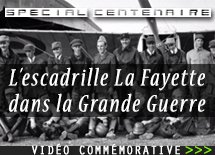The Lafayette Escadrille
Sous-titre
in the Great War

? Exclusivité cheminsdememoire.gouv.f vidéo commémorative
Dossier de presse spécial centenaire
©Ministère de la défense - DMPA/SDMAE/BAPI
Cliquez sur le visuel pour visionner le film
On 4 July 1917, a huge crowd accompanied General John Pershing from Les Invalides to the Parisian cemetery of Picpus. Laying flowers and bowing at the tomb of the Marquis de Lafayette, he acknowledged the gratitude of the American people to this French officer who had fought by their side for independence. This was the occasion when Colonel Stanton uttered the immortal words: ”Lafayette, we are here!” The United States had entered the war on the side of France and her allies on 6 April1917. Yet, while the first troops were disembarking on French soil, American citizens were already fighting in France, including those in the Lafayette Escadrille.
Indeed, as soon as war broke out, many young Americans living in France wanted to fight on the side of the French Republic. Some were engaged as non-combatant drivers in the voluntary ambulance service. Others joined the French Foreign Legion, the only means of fighting for France while keeping their American nationality. Some, trained pilots who had already fought in the trenches, signed up to the French aeronautical service. This was the case with William Thaw and Eliot Cowdin. These two pilots, along with a third, Norman Prince, worked tirelessly to secure from the French authorities the establishment of a squadron composed entirely of American pilots. They returned to the United States in December 1915 where they received a hero's welcome. After long negotiations and a supportive press campaign, in both France and the United States, they succeeded. In March 1916 the French aeronautical service decided to assemble all American airmen into one squadron which would be under the command of a French captain.
Seven young American pilots were eventually selected: Prince, Thaw and Cowdin, the project's initiators, were joined by Victor Chapman, James MacConnell, Kiffin Rockwell and Bert Hall. Captain Georges Thénault was appointed as the officer in charge of the squadron. Lieutenant de Laage de Meux became his second in command.
124 Squadron was created on 18 April 1916 and its first American pilots were installed at its base on 20 April. Finally christened Escadrille Lafayette on 16 December 1916, it chose as its emblem a Sioux chief's head, as a symbol of strength, fighting spirit and courage.
Originally based at Luxeuil-les-Bains, in the foothills of the Vosges, the squadron received orders to leave for Verdun in May 1916, to carry out important reconnaissance missions. There it stayed until September before returning to its base at Luxeuil. On 18 May 1916 Kiffin Rockwell scored the squadron's first victory by bringing down a German plane. Very soon, new pilots were needed to replace those who either did not return from their missions or were injured in aerial combat or by ground fire. The squadron's ranks swelled: by the end of the month there were over a dozen pilots, and French flying ace Charles Nungesser joined for a few weeks in the summer of 1916.
During the 23 months of engagement in the conflict, the squadron was active on the whole of the western front, from the Vosges to Picardie, and always on the front line. The 38 American pilots and their five French officers carried out more than 3,000 combat missions and secured 39 official victories, with up to 100 unconfirmed, against enemy aircraft. Nine of their number died in aerial combat.
The Escadrille Lafayette contributed to shaping American public opinion by example and by demonstrating the realities of the French war effort. It also helped to link the two countries and encouraged a realisation that the war was more than simply a local conflict between European powers. On both sides of the Atlantic the Escadrille Lafayette symbolised the best of the Franco-American alliance that had existed from 1777, since the days of Lafayette and Washington.
With the American and French press relaying the squadron's exploits, a large number of young Americans dreamed of joining them. Yet demand greatly exceeded the few places available, and thus, in mid-June 1916, the Lafayette Flying Corps was created, enabling new American volunteers to be allocated to other French squadrons. Including all the volunteers allocated to the Lafayette Flying Corps, the number of American pilots who fought for France rose to 269, distributed to over 24 French units.
With 17 confirmed victories, 16 of which were with the Escadrille Lafayette, Raoul Lufbery is one of the greatest American flying aces of the First World War. Born of an American father and a French mother, he had opted for American nationality and enlisted in the French Foreign Legion in August 1914, before joining the Escadrille Lafayette on 24 May 1916. Awarded the Croix de Guerre and promoted to Chevalier de la Legion d'Honneur, William Thaw is the only American to have been elevated to officer rank by the French army. On 10 January 1918 he was promoted to Major in the US Army Air Service. On 18 February 1918 the Escadrille Lafayette was formally transferred to the American army. Under the number 103, it became the foremost pursuit squadron in the United States Air Force
Raoul Lufbery's career ended when his plane was shot down on 19 May 1918. Today his body lies with those of his comrades at the Escadrille Lafayette Memorial.
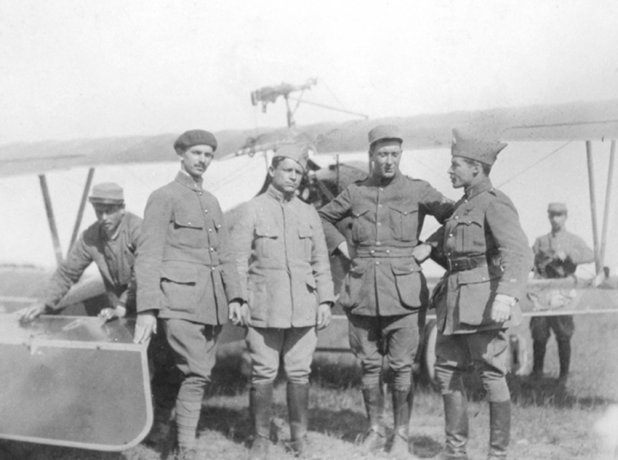
Balsley, Lufbery, McConnell, Prince
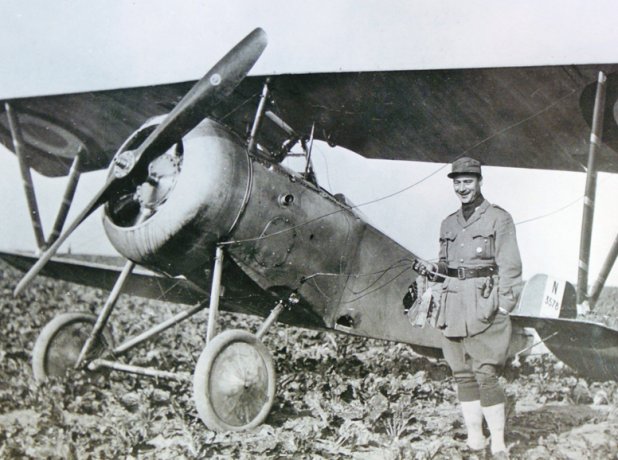
Le pilote Andrew Courtney Campbell
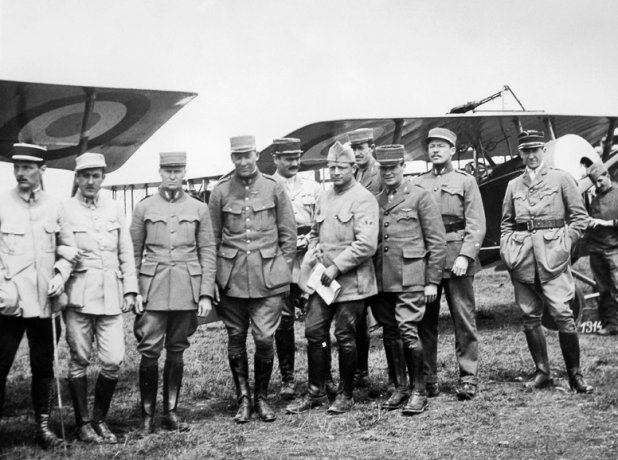
Les pilotes De Laage de Meux, Johnson, Rumsey, McConnell,Thaw, Lufbery, Rockwell, Masson, Prince,Hall
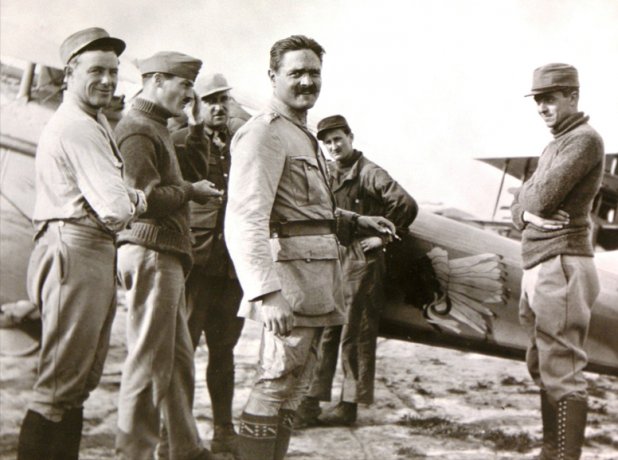
Les pilotes Soubiran, Haviland ou Campbell, Marr, Thaw et Peterson avec leurs mécaniciens français
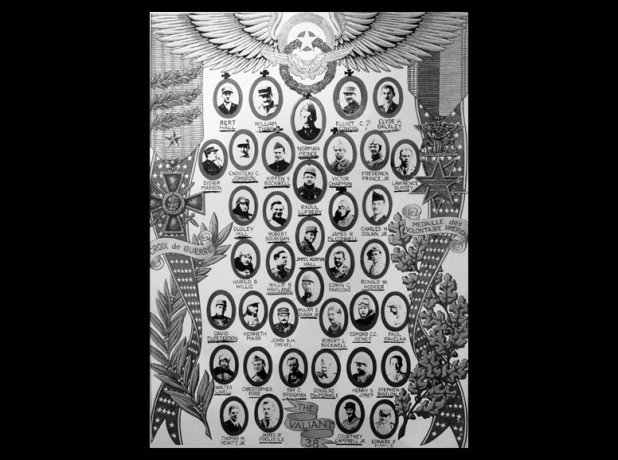
Les "vaillants 38"
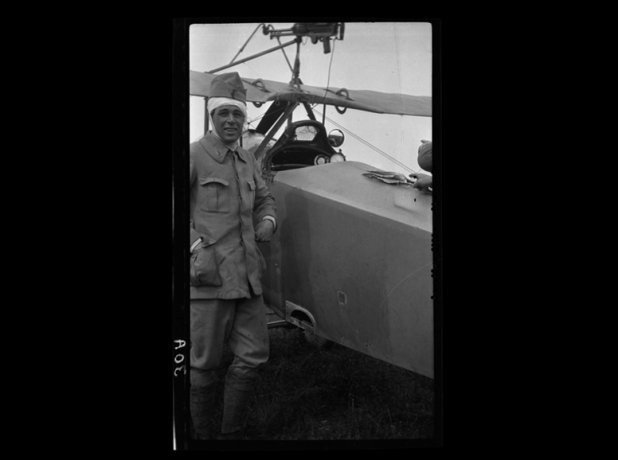
Le pilote Victor Chapman, blessé à la tête en juin 1916.


